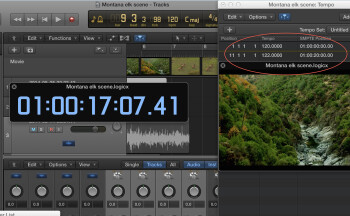Writing music to fit with the visual elements in a video, the process known as "scoring to picture," requires additional skills beyond just being able to compose music. In this series we'll show you what those are, and give you the basic knowledge to be able to do your own scoring projects.
Different world
When composing music for picture, you don’t have the freedom to totally follow your muse, because you’re working under what are typically pretty tight constraints. First, the length of the piece (or pieces) of music that you write must conform to the allotted time in the video or film. Whether it’s for a TV commercial, which would likely be 30 seconds long or less, or for a scene in a video or film, you not only must compose music with the right feel and attitude, it also needs be the right length. Second, you’ll likely be asked to actively reinforce certain visual events with your music (referred to as “hit points”), and to do so, you need to know how to structure your music to make that happen. Third, you’re usually asked to complete your work under tight deadline conditions, so you need to be able to work fast.
Unless you’re also producing the video, another constraint you’ll have to deal with is pleasing your client, whether that’s the director of a movie or TV show, or the ad agency producer for a commercial. When you’re a composer-for-hire on someone else’s project, you don’t have the final creative say. You have to be flexible and know how to roll with the punches if you want to get anywhere as a film or TV composer. But we’re getting ahead of ourselves, here. Let’s start with some basics.
The variables
Imagine if you were to load a video clip into your DAW and then choose any piece of music from your collection, load it into the session, and play the video and music together. By random chance there would likely be some spots where the music seemed synchronized with something happening in the video — for instance where a musical beat occurred simultaneously to a cut (edit) from one shot to another in the picture. It would be even more powerful if that beat was the downbeat of a measure.
If you then sped or slowed down the tempo of the music, you’d notice that the relationship between the music and picture changed completely. Beats and visual events that were lined up previously wouldn’t be any more, and vice-versa. The same thing would happen if you were to slide the music’s start point forward by a frame or two — the beats would occur in different spots relative to events in the picture, which are fixed in relation to elapsed time.
That little thought experiment highlights two of the most important variables that you work with when scoring to picture: the tempo and the start time of the music. There are others, such as changes in meter, which can also be useful when you’re trying to make the music hit a specific point.
In the next installment, we’ll go step by step through a hypothetical scoring project, to let you see inside the process.


